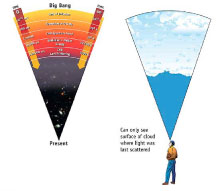A Foggy Universe...
The Origin of the Microwave Background

|
We can only see the bottom surface of clouds in our atmosphere
because that's where light no longer scatters off the water
molecules in the cloud. Similarly, we can only see clearly into
space to where the microwave background was last scattered
off the electron haze in the early universe.
(Click on image to enlarge it.)
|
First, let's visit that time 400,000 years after the Big Bang just before light first broke free. In human terms, the Universe was only 12 hours old; stars wouldn't turn on until the Universe was ready to enter grade school. The universe was hot and crowded then, about 1/1000th its current size. All the matter that exists today, all the protons and all the electrons, were crammed together.
The average temperature was about 4,000 degrees. At that temperature, electrons could not bind with protons. Instead, the electrons buzzed about in a haze.
As the Universe expanded it cooled. When the Universe was a "chilly" 2,700 degrees, electrons could join protons to form the first hydrogen molecules. With no electron haze, the light created by the Big Bang could at long last could shine through the Universe. The light was released simultaneously across the entire Universe -- and not from one point like other types of light we are familiar with. The Universe continues to expand. And that first light to break free continues to shine.
Imagine the Universe as a loaf of rising raisin bread, in which the
nearly formed galaxies are the raisins. The region in space that
ultimately became home to the Milky Way galaxy is moving away from all
the other regions... or all the other raisins in the bread. Now imagine that first light that was released simultaneously everywhere in the Universe. Light released within our own region has long since passed us. Light released in regions very far from us, however, is just reaching us now.
This is the microwave background we see today. This is the afterglow
of the Big Bang from regions so far away that, traveling at the speed
of light, it took billions of years to reach us. Likewise, regions of
space billions of years from us are receiving the light from the Big
Bang that was produced in our region of the Universe. Today, we are
detecting microwave photons that last interacted with matter 15
billion years ago in a region 15 billion light years away. Perhaps,
the photons that interacted 15 billion years ago with
the electrons that make up our own bodies are now being detected
by observers in some distant galaxy.
Additional Links
 MAP Home Page (http://map.gsfc.nasa.gov)
MAP Home Page (http://map.gsfc.nasa.gov)
|
